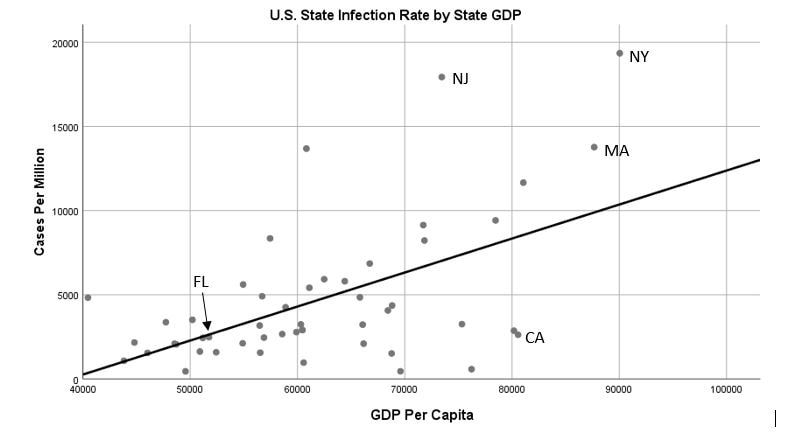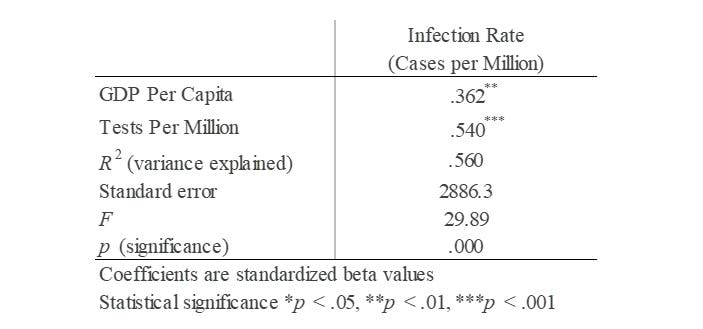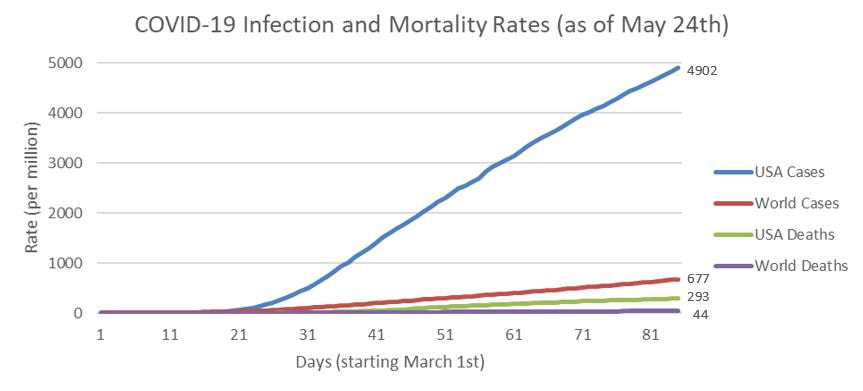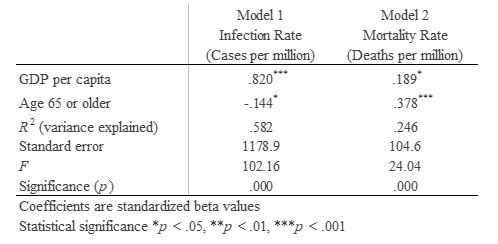|
Due to popular demand, I performed another brief analysis of the COVID-19 infection rate, this time looking at the United States by individual state. The results were similar to the international findings, previously posted. The infection rate (# cases per million population) is strongly correlated with economic strength (GDP per capita) at the state level, just as it was at the country level. This continues to suggest that economic activity promotes greater social contact allowing for the transmission of the virus. The following scatter plot illustrates the relationship (dots represent 50 U.S. states.) Since we also have good data on COVID-19 testing in the United States, I added it to the analysis by regressing the infection rate on both the economic strength and the testing rate of each state. The following table shows that both variables are strongly related to the reported number of cases and together explain 56% of the variance in the state-level data. Comparatively, the amount of testing has a larger effect (.540) than the economy (.362) on the infection rate while both are statistically significant. So what does this tell us? The finding relative to testing should come as no surprise. States and countries that test more will find more positive cases. However, the finding relative to GDP is troublesome. The COVID-19 virus disproportionately affects strong economies, presumably due to the high level of contagion coupled with the high level of social contact involved in economic activity. More sophisticated research with many other factors is warranted. But the analysis highlights the vulnerability of economically developed regions to pandemic, and suggests the need to elevate this issue in our thinking about local preparedness as well as national defense.
Sources: Worldometer for COVID-19 data by state as of May 28, 2020. Retrieved from www.worldometers.info/coronavirus U.S. Bureau of Economic Analysis for GDP data by state for Q4 2019 (seasonally adjusted.) Retrieved from www.bea.gov/data/gdp/gdp-state Why in the world (literally) is the U.S. leading the pack in the number of COVID-19 cases and deaths? While the media continues to focus on the speed and severity of different countries’ lockdown measures, I suspect there is something more basic, more demographic, at work. Fortunately, we have a growing number of quality data sets on the pandemic and I finally had a chance to run some statistics this weekend. The two variables I was interested in were the size of the economy and the age of the population. The U.S. is an economic powerhouse and a strong economy suggests a high level of social engagement through business, recreation, travel, etc. To measure the economy, I used Gross Domestic Product (GDP) per capita. The U.S. is also an older country in terms of the average age of its population. This may be related to the economy, as a higher GDP per capita suggests better living conditions, healthcare, and other factors related to living longer. To measure age, I used the percentage of the population aged 65 or older, which is where we find the majority of deaths from COVID-19. I pulled the data on May 24th for 153 countries (with at least 100 COVID-19 cases each) from the Our World in Data COVID-19 data set which is available at https://github.com/owid/covid-19-data/tree/master/public/data. This data set integrates multiple sources including the European Centre for Disease Prevention and Control, World Bank, UN, and national government reports. A couple of regression models were all it took to confirm my suspicions, as shown by the following table. Looking first at the infection rate, both the economy and age were significantly related to the number of reported COVID-19 cases per million, with GDP per capita having a very strong effect (.820). The age variable was actually negatively related to the infection rate, suggesting that older individuals were less involved in the propagation of the contagion. Looking at the mortality rate, both variables were positively related to the number of reported COVID-19 deaths per million. Here, age 65 or older had the stronger effect (.378). The statistical significance of both models was very high (p < .001). This quick study is just one of many that are sure to come, addressing other relevant factors such as testing, asymptomatic cases, urban density, lockdown policies, hospital beds, PPE availability, gender, etc. However, the study clearly shows that economic activity is tied to the infection rate, and the vulnerability of the population is tied to the mortality rate. Not too surprising when you think about it.
One of the few positive outcomes of the COVID-19 pandemic is the recognition by many individuals and companies that work can be effectively accomplished remotely or online. Some companies like SAS (software) have been doing it successfully for years, offering their employees greater work-life balance, attracting top talent, and decreasing their facility capital costs at the same time. There is certainly room in many industries to harness these benefits by employing more work from home.
But it's important to keep in mind the limitations of this trend. Working remotely works great for “knowledge workers.” Peter Drucker coined this term in 1952 to refer to the growing number of occupations involving “the ability to acquire and to apply theoretical and analytical knowledge.” Doctors, lawyers, accountants, engineers, scientists, and managers are good examples. An accountant can certainly prepare tax returns from a home office. An author can write an article (like this one) from anywhere. Telemedicine is well underway. However, the proportion of knowledge workers is only about 30% in developed countries (Arthur, DeFillippi, & Lindsay, 2008). Restauranteurs, hoteliers, construction workers, professional athletes, entertainers, first responders, factory workers, mechanics, airline pilots, soldiers, plumbers, electricians…the list goes on…just can't work very well from home. Even amongst the 30% who are knowledge workers, many professions require access to specialized equipment or close collaboration with others to do their job. Scientists need laboratories. Creatives need social-organizational structure and a conducive physical environment (Dul, Ceylan, & Jaspers, 2011). Discounting our knowledge worker group by these individuals suggests that only around 20% to 25% of the economy may benefit from remote work. During an emergency like the pandemic, the shift to remote work wherever possible makes great sense. The question becomes which areas are best suited for retaining the remote workforce once the emergency subsides? For this, I would return to Dr. Drucker who identified six key factors driving productivity in knowledge work (Drucker, 1999). These are:
References Arthur, M. B., DeFillippi, R. J., & Lindsay, V. J. (2008). On Being a Knowledge Worker. Organizational Dynamics, 37(4), 365-377. Drucker, P. F. (1999). Knowledge-Worker Productivity: The Biggest Challenge. California Management Review, 41(2), 79-94. Dul, J., Ceylan, C., & Jaspers, F. (2011). Knowledge Workers’ Creativity and the Role of the Physical Environment. Human Resource Management, 50(6), 715-734. |





